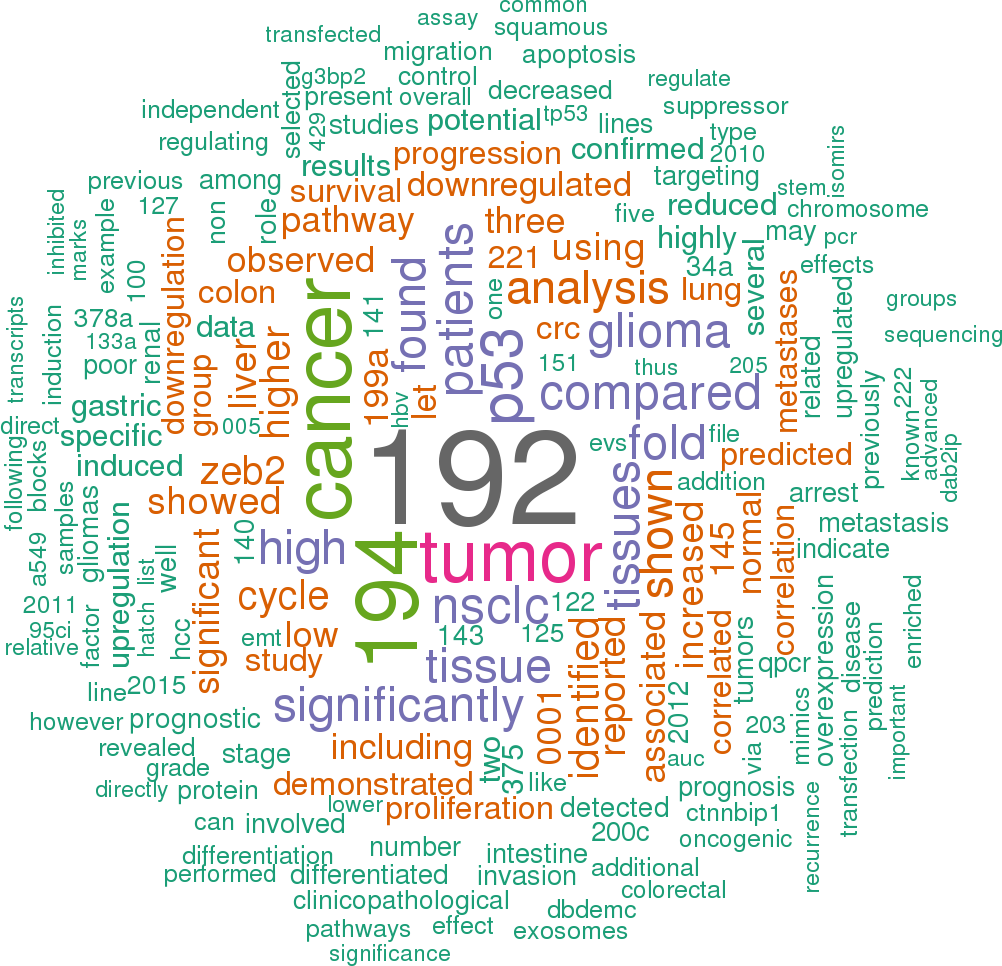Accession
MI0000291
Symbol
HGNC:
MIR215
Description
Homo sapiens
hsa-mir-215 precursor miRNA mir-192
Gene
family?
family?
RF00130;
mir-192
Summary
Caution, this is an AI generated summary based on literature. This may have errors. ?
Hsa-mir-215 is a microRNA (miRNA) that has been implicated in various biological processes and diseases, with a particular focus on its role in cancer. It is one of the miRNAs with fewer than 20 validated targets in miRTarBase, indicating its potential specificity in gene regulation [PMC5484592]. This miRNA has been associated with the regulation of pathways significantly overrepresented among its target genes, suggesting its involvement in critical biological functions [PMC8876010]. In soft tissue sarcoma (STS) metastasis, hsa-mir-215 and thymidylate synthase (TYMS) have been proposed as potential prognostic indicators for chemotherapeutic benefits [PMC4434893]. Additionally, hsa-mir-215's expression levels have been linked to disease stage and colorectal cancer (CRC)-specific mortality [PMC6007480]. It has shown differential expression patterns in various cancers, including upregulation in NPM1 mutated acute myeloid leukemia (AML) [PMC7851519] and a strong correlation with esophageal neoplasms [PMC6929455]. However, hsa-mir-215 expression is significantly lower in tumor tissues compared to adjacent normal colon epithelial tissue [PMC8798538], suggesting a complex role in tumorigenesis. Mechanistically, it can be inhibited by circ_0005046 acting as a miRNA sponge [PMC8233096], and it is one of the upregulated miRNAs identified by an IM signature that includes both upregulated and downregulated miRNAs associated with cancer progression [PMC3671360]. Finally, hsa-mir-215's expression patterns have been validated using pre-designed RT2 qPCR assays for accurate quantification [PMC5764254], underscoring its relevance as a biomarker for disease diagnosis or prognosis.
Literature search

102 open access papers mention hsa-mir-215
(417 sentences)
(417 sentences)
Sequence
21961
reads,
75
reads per million, 86 experiments
aucauucagaaaugguauacaggaaaAUGACCUAUGAAUUGACAGACaauauagcugaguuugUCUGUCAUUUCUUUAGGCCAAUAuucuguaugacugugcuacuucaa
...........(((((((((((((...((.((((.(((.((((((((((...........)))))))))).)))..)))).))...)))))))).)))))..........
...........(((((((((((((...((.((((.(((.((((((((((...........)))))))))).)))..)))).))...)))))))).)))))..........
Structure
aucauucagaa - aaA A -U U uaua
auggu auacagga UG CCUA GAA UGACAGACaa g
||||| |||||||| || |||| ||| |||||||||| c
uguca uaugucuu AC GGAU CUU ACUGUCUguu u
-aacuucaucg g AUA C UU U ugag
Annotation confidence
Not enough data
Do you think this miRNA is real?
Comments
This human miRNA was predicted by computational methods using conservation with mouse and Fugu rubripes sequences [1]. Expression of the excised miR has been validated in zebrafish, and the 5' end mapped by PCR. Landgraf et al. confirm expression in human [2].
Genome context
chr1: 220117853-220117962 [-]
Clustered miRNAs
1 other miRNA is < 10 kb from hsa-mir-215
| Name | Accession | Chromosome | Start | End | Strand | Confidence |
|---|
Disease association
hsa-mir-215 is associated with one or more human diseases in the Human microRNA Disease Database
| Disease | Description | Category | PubMed ID |
|---|
Biological pathways
hsa-mir-215 is involved in one or more biological pathways:
(Source: Reactome)
(Source: Reactome)
Biological reactions
hsa-mir-215 is involved in one or more regulation/signalling events:
(Source: Reactome)
(Source: Reactome)
Mature hsa-miR-215-5p
| Accession | MIMAT0000272 |
| Description | Homo sapiens hsa-miR-215-5p mature miRNA |
| Sequence | 27 - AUGACCUAUGAAUUGACAGAC - 47 |
| Evidence |
experimental
cloned [2], Illumina [3] |
| Database links |



|
| Predicted targets |


|
Mature hsa-miR-215-3p
| Accession | MIMAT0026476 |
| Description | Homo sapiens hsa-miR-215-3p mature miRNA |
| Sequence | 64 - UCUGUCAUUUCUUUAGGCCAAUA - 86 |
| Evidence |
experimental
Illumina [3] |
References
|




